Basque language
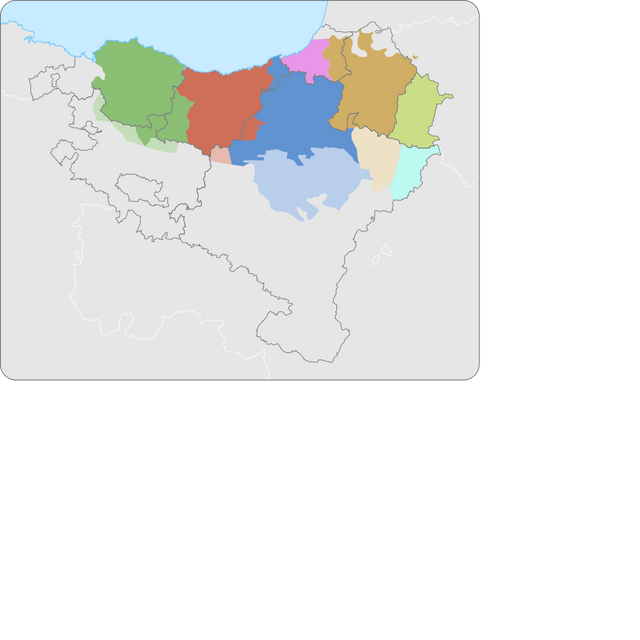
Basque language

| Basque | ||||
|---|---|---|---|---|
| euskara | ||||
| Pronunciation | IPA: [eus̺ˈkaɾa] | |||
| Native to | Spain, France | |||
| Region | Basque Country, Basque diaspora. | |||
| Ethnicity | Basque | |||
Native speakers | 750,000 [1] (2016) 1,185,500 passive speakers | |||
Language isolate (Vasconic) | ||||
Early forms | Proto-Basque
| |||
| Dialects |
| |||
Writing system | Basque alphabet (Latin script) Basque Braille | |||
| Official status | ||||
Official language in | ||||
Recognised minority language in | ||||
| Regulated by | Euskaltzaindia | |||
| Language codes | ||||
| ISO 639-1 | eu [119] | |||
| ISO 639-2 | baq [120] (B)eus [121] (T) | |||
| ISO 639-3 | eus | |||
| Glottolog | basq1248 [122][2] | |||
| Linguasphere | 40-AAA-a | |||
 Basque speakers + passive speakers (2011).
| ||||
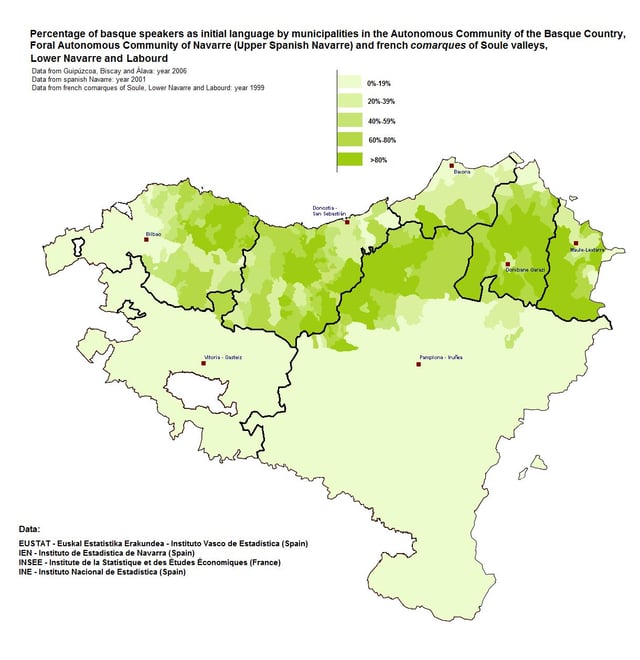
Family transmission of Basque language (Basque as initial language)
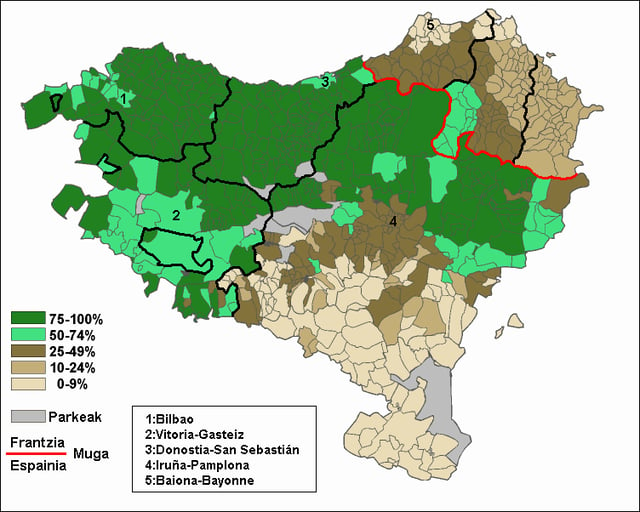
Percentage of students registered in Basque language schools (2000–2005).

Location of the Basque-language provinces within Spain and France
Basque(/bæsk, bɑːsk/;[3] euskara [eus̺ˈkaɾa]) is a language spoken in the Basque Country, a region that straddles the westernmost Pyrenees in adjacent parts of northern Spain and southwestern France. Linguistically, Basque is unrelated to the other languages of Europe and is a language isolate relative to any other known living language. The Basques are indigenous to, and primarily inhabit, the Basque Country. The Basque language is spoken by 28.4% (751,500) of Basques in all territories. Of these, 93.2% (700,300) are in the Spanish area of the Basque Country and the remaining 6.8% (51,200) are in the French portion.[1]
Native speakers live in a contiguous area that includes parts of four Spanish provinces and the three "ancient provinces" in France. Gipuzkoa, most of Biscay, a few municipalities of Álava, and the northern area of Navarre formed the core of the remaining Basque-speaking area before measures were introduced in the 1980s to strengthen the language. By contrast, most of Álava, the western part of Biscay and central and southern areas of Navarre are predominantly populated by native speakers of Spanish, either because Basque was replaced by Spanish over the centuries, in some areas (most of Álava and central Navarre), or because it was possibly never spoken there, in other areas (parts of the Enkarterri and southeastern Navarre).
In Francoist Spain, Basque language use was affected by the repressive policies. In the Basque Country, "Francoist repression was not only political, but also linguistic and cultural".[4] The regime placed legal restrictions on the use of language, which was suppressed from official discourse, education, and publishing,[5] making it illegal to register new-born babies under Basque names,[6] and even requiring tombstone engravings in Basque to be removed.[7] In some provinces, the public use of the language was suppressed, with people fined for speaking Basque.[8] Public use of Basque was frowned upon by supporters of the regime, often regarded as a sign of anti-Francoism or separatism;.[9] Overall, in the 1960s and later, the trend reversed and education and publishing in Basque began to flourish.[10] As a part of this process, a standardised form of the Basque language, called Euskara Batua, was developed by the Euskaltzaindia in the late 1960s. Besides its standardised version, the five historic Basque dialects are Biscayan, Gipuzkoan, and Upper Navarrese in Spain, and Navarrese–Lapurdian and Souletin in France. They take their names from the historic Basque provinces, but the dialect boundaries are not congruent with province boundaries. Euskara Batua was created so that the Basque language could be used—and easily understood by all Basque speakers—in formal situations (education, mass media, literature), and this is its main use today. In both Spain and France, the use of Basque for education varies from region to region and from school to school.[11]
A language isolate, Basque is believed to be one of the few surviving pre-Indo-European languages in Europe, and is the only one in Western Europe. The origin of the Basques and of their languages is not conclusively known, though the most accepted current theory is that early forms of Basque developed before the arrival of Indo-European languages in the area, including the Romance languages that geographically surround the Basque-speaking region. Basque has adopted a good deal of its vocabulary from the Romance languages, and Basque speakers have in turn lent their own words to Romance speakers.
The Basque alphabet uses the Latin script.
| Basque | ||||
|---|---|---|---|---|
| euskara | ||||
| Pronunciation | IPA: [eus̺ˈkaɾa] | |||
| Native to | Spain, France | |||
| Region | Basque Country, Basque diaspora. | |||
| Ethnicity | Basque | |||
Native speakers | 750,000 [1] (2016) 1,185,500 passive speakers | |||
Language isolate (Vasconic) | ||||
Early forms | Proto-Basque
| |||
| Dialects |
| |||
Writing system | Basque alphabet (Latin script) Basque Braille | |||
| Official status | ||||
Official language in | ||||
Recognised minority language in | ||||
| Regulated by | Euskaltzaindia | |||
| Language codes | ||||
| ISO 639-1 | eu [119] | |||
| ISO 639-2 | baq [120] (B)eus [121] (T) | |||
| ISO 639-3 | eus | |||
| Glottolog | basq1248 [122][2] | |||
| Linguasphere | 40-AAA-a | |||
 Basque speakers + passive speakers (2011).
| ||||
Names of the language
In Basque, the name of the language is officially Euskara (alongside various dialect forms).
In French, the language is normally called basque, though in recent times euskara has become common. Spanish has a greater variety of names for the language. Today, it is most commonly referred to as el vasco, la lengua vasca, or el euskera. Both terms, vasco and basque, are inherited from Latin ethnonym Vascones, which in turn goes back to the Greek term οὐασκώνους (ouaskōnous), an ethnonym used by Strabo in his Geographica (23 CE, Book III).[12]
The Spanish term Vascuence, derived from Latin vasconĭce,[13] has acquired negative connotations over the centuries and is not well-liked amongst Basque speakers generally. Its use is documented at least as far back as the 14th century when a law passed in Huesca in 1349 stated that Item nuyl corridor nonsia usado que faga mercadería ninguna que compre nin venda entre ningunas personas, faulando en algaravia nin en abraych nin en basquenç: et qui lo fara pague por coto XXX sol—essentially penalising the use of Arabic, Hebrew, or Basque in marketplaces with a fine of 30 sols (the equivalent of 30 sheep).[14]
History and classification

Geographical traces of the Basque language. Blue dots: place names; red dots: epigraphic traces (gravestones...) in the Roman times; blue patch: maximum extension.
Basque is geographically surrounded by Romance languages but is a language isolate unrelated to them, and indeed, to any other language in the world. It is the last remaining descendant of one of the pre-Indo-European languages of Western Europe, the others being extinct outright.[12] Consequently, its prehistory may not be reconstructible by means of the traditional comparative method except by applying it to differences between dialects within the language. Little is known of its origins, but it is likely that an early form of the Basque language was present in Western Europe before the arrival of the Indo-European languages in the area.
Authors such as Miguel de Unamuno and Louis Lucien Bonaparte have noted that the words for "knife" (aizto), "axe" (aizkora), and "hoe" (aitzur) derive from the word for "stone" (haitz), and have therefore concluded that the language dates to prehistoric Europe when those tools were made of stone.[15][16] Others find this unlikely: see the aizkora controversy.
Latin inscriptions in Gallia Aquitania preserve a number of words with cognates in the reconstructed proto-Basque language, for instance, the personal names Nescato and Cison (neskato and gizon mean "young girl" and "man", respectively in modern Basque). This language is generally referred to as Aquitanian and is assumed to have been spoken in the area before the Roman Republic's conquests in the western Pyrenees. Some authors even argue for late Basquisation, that the language moved westward during Late Antiquity after the fall of the Western Roman Empire into the northern part of Hispania into what is now Basque Country.[12]
Roman neglect of this area allowed Aquitanian to survive while the Iberian and Tartessian languages became extinct. Through the long contact with Romance languages, Basque adopted a sizeable number of Romance words. Initially the source was Latin, later Gascon (a branch of Occitan) in the northeast, Navarro-Aragonese in the southeast and Spanish in the southwest.
Hypotheses concerning Basque's connections to other languages
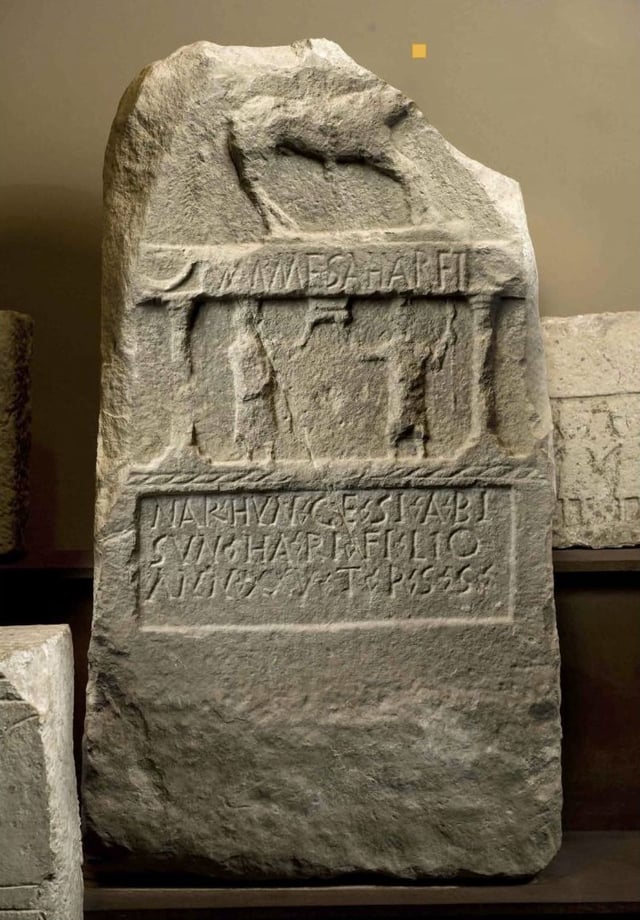
Inscription with Basque-like lexical forms identified as "UME ZAHAR", Lerga (Navarre)
The statistical improbability and chronological difficulty of linking Basque with its Indo-European neighbours in Europe has inspired many scholars to search for its possible relatives elsewhere. Besides many pseudoscientific comparisons, the appearance of long-range linguistics gave rise to several attempts to connect Basque with geographically very distant language families. Almost all hypotheses concerning the origin of Basque are controversial, and the suggested evidence is not generally accepted by most linguists. Some of these hypothetical connections are:
Iberian: another ancient language once spoken in the Iberian Peninsula, shows several similarities with Aquitanian and Basque. However, not enough evidence exists to distinguish geographical connections from linguistic ones. Iberian itself remains unclassified. Eduardo Orduña Aznar claims to have established correspondences between Basque and Iberian numerals[17] and noun case markers.
Indo-European: possibly close to (Italo-)Celtic or an Indo-European creole possibly with a donor language akin to Brittonic on a substrate language akin to Italic.[18][19] Gianfranco Forni considers it unrealistic that Basque is a non-Indo-European language that allegedly borrowed the majority of its basic lexicon (including virtually all verbs) and most of its archaic bound morphemes from neighbouring Indo-European languages.[18] In response, a non-Indo-European line of descent with waves or stages of Indo-European influence and minor discontinuities over probably millennia before the Roman conquest[20] was suggested as the most likely alternative by John T. Koch in his review of Forni's paper outlining why an Indo-European classification of Basque cannot be accepted, even if some of Forni's data is accepted.[20]
Vasconic substratum theory: This proposal, made by the German linguist Theo Vennemann, claims that enough toponymical evidence exists to conclude that Basque is the only survivor of a larger family that once extended throughout most of Western Europe, and has also left its mark in modern Indo-European languages spoken in Europe.
Ligurian substrate: This hypothesis proposed in the 19th century by d'Arbois de Jubainville, J. Pokorny, P. Kretschmer and several other linguists encompasses the Basco-Iberian hypothesis.
Georgian: Linking Basque to the Kartvelian languages is now widely discredited. The hypothesis was inspired by the existence of the ancient Kingdom of Iberia in the Caucasus and further by some typological similarities between the two languages.[21] According to J. P. Mallory, the hypothesis was also inspired by a Basque place-name ending in -dze which is common in Kartvelian.[22] The theory suggested that Basque and Georgian were remnants of a pre-Indo-European group.
Northeast Caucasian, such as Chechen, are seen by some linguists as more likely candidates for a very distant connection.[23]
Dené–Caucasian: Based on the possible Caucasian link, some linguists, for example John Bengtson and Merritt Ruhlen, have proposed including Basque in the Dené–Caucasian superfamily of languages, but this proposed superfamily includes languages from North America and Eurasia, and its existence is highly controversial.[12]
Dogon: The philologist Javier Martín Martín investigated on the subject and states that Basque is derived from Dogon, spoken in north-western Africa. This claim has been harshly contested by Xabier Kintana of the Euskaltzaindia, who says that this theory makes no sense and consists of "cheap speculation", and criticises the lack of methodology.[24]
Geographic distribution
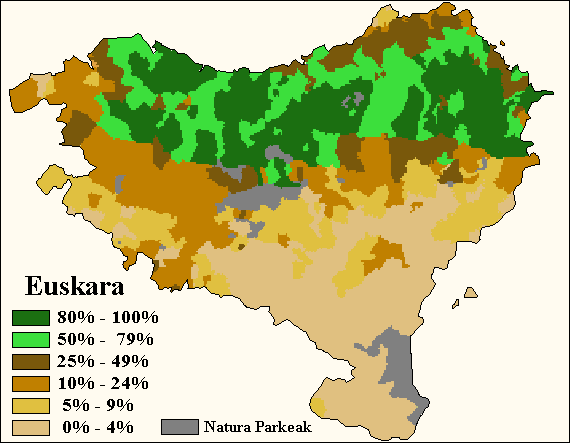
Percentage of fluent speakers of Basque (areas where Basque is not spoken are included within the 0–4% interval)

Percentage of people fluent in Basque language in Navarre (2001), including second-language speakers
The region where Basque is spoken has become smaller over centuries, especially at the northern, southern, and eastern borders. Nothing is known about the limits of this region in ancient times, but on the basis of toponyms and epigraphs, it seems that in the beginning of the Common Era it stretched to the river Garonne in the north (including the southwestern part of present-day France); at least to the Val d'Aran in the east (now a Gascon-speaking part of Catalonia), including lands on both sides of the Pyrenees;[25] the southern and western boundaries are not clear at all.
The Reconquista temporarily counteracted this contracting tendency when the Christian lords called on Northern Iberian peoples—Basques, Asturians, and "Franks"—to colonise the new conquests. The Basque language became the main everyday language, while other languages like Spanish, Gascon, French, or Latin were preferred for the administration and high education.
In 1807, Basque was still spoken in the northern half of Álava—including its capital city Vitoria-Gasteiz[27]—and a vast area in central Navarre, but in these two provinces, Basque experienced a rapid decline that pushed its border northwards. In the French Basque Country, Basque was still spoken in all the territory except in Bayonne and some villages around, and including some bordering towns in Béarn.
In the 20th century, however, the rise of Basque nationalism spurred increased interest in the language as a sign of ethnic identity, and with the establishment of autonomous governments in the Southern Basque Country, it has recently made a modest comeback. In the Spanish part, Basque-language schools for children and Basque-teaching centres for adults have brought the language to areas such as western Enkarterri or the Ribera del Ebro in southern Navarre, where it is not known if it has ever been spoken before; and in the French Basque Country, these schools and centres have almost stopped the decline of the language.
Official status
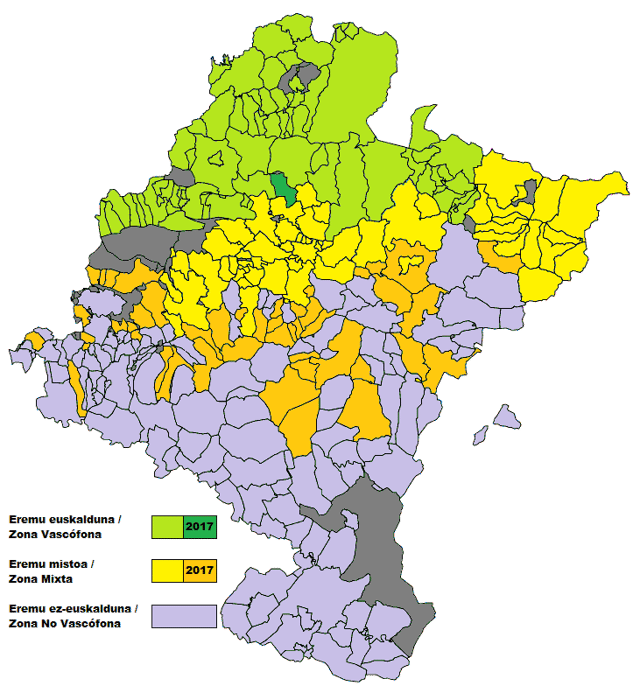
Official status of the Basque language in Navarre
Historically, Latin or Romance languages have been the official languages in this region. However, Basque was explicitly recognised in some areas. For instance, the fuero or charter of the Basque-colonised Ojacastro (now in La Rioja) allowed the inhabitants to use Basque in legal processes in the 13th and 14th centuries.
The Spanish Constitution of 1978 states in Article 3 that the Spanish language is the official language of the nation, but allows autonomous communities to provide a co-official language status for the other languages of Spain.[28] Consequently, the Statute of Autonomy of the Basque Autonomous Community establishes Basque as the co-official language of the autonomous community. The Statute of Navarre establishes Spanish as the official language of Navarre, but grants co-official status to the Basque language in the Basque-speaking areas of northern Navarre. Basque has no official status in the French Basque Country and French citizens are barred from officially using Basque in a French court of law. However, the use of Basque by Spanish nationals in French courts is permitted (with translation), as Basque is officially recognised on the other side of the border.
The positions of the various existing governments differ with regard to the promotion of Basque in areas where Basque is commonly spoken. The language has official status in those territories that are within the Basque Autonomous Community, where it is spoken and promoted heavily, but only partially in Navarre. The Ley del Vascuence ("Law of Basque"), seen as contentious by many Basques, but considered fitting Navarra's linguistic and cultural diversity by some of the main political parties of Navarre,[29] divides Navarre into three language areas: Basque-speaking, non-Basque-speaking, and mixed. Support for the language and the linguistic rights of citizens vary, depending on the area. Others consider it unfair, since the rights of Basque speakers differ greatly depending on the place they live.
Demographics
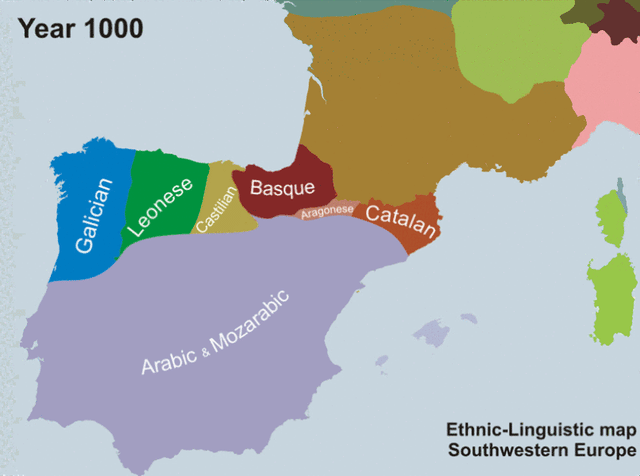
Map showing the historical retreat and expansion of Basque within the context of its linguistic neighbours between the years 1000 and 2000

Testimonies of Basque sociolinguistic dynamics (French Basque Country)
The 2006 sociolinguistic survey of all Basque-speaking territories showed that in 2006, of all people aged 16 and above:[30]
In the Basque Autonomous Community, 30.1% were fluent Basque speakers, 18.3% passive speakers and 51.5% did not speak Basque. The percentage was highest in Gipuzkoa (49.1% speakers) and lowest in Álava (14.2%). These results represent an increase from previous years (29.5% in 2001, 27.7% in 1996 and 24.1% in 1991). The highest percentage of speakers can now be found in the 16–24 age range (57.5%) vs. 25.0% in the 65+ age range. The percentage of fluent speakers is even higher if counting those under 16, given that the proportion of bilinguals is particularly high in this age group (76.7% of those aged between 10 and 14 and 72.4% of those aged 5–9): 37.5% of the population aged 6 and above in the whole Basque Autonomous Community, 25.0% in Álava, 31.3% in Biscay and 53.3% in Gipuzkoa.[31]
In French Basque Country, 22.5% were fluent Basque speakers, 8.6% passive speakers, and 68.9% did not speak Basque. The percentage was highest in Labourd and Soule (55.5% speakers) and lowest in the Bayonne-Anglet-Biarritz conurbation (8.8%). These results represent another decrease from previous years (24.8% in 2001 and 26.4 in 1996). The highest percentage of speakers is in the 65+ age range (32.4%). The lowest percentage is found in the 25–34 age range (11.6%), but there is a slight increase in the 16–24 age range (16.1%)
In Navarre, 11.1% were fluent Basque speakers, 7.6% passive speakers, and 81.3% did not speak Basque. The percentage was highest in the Basque-speaking zone in the north (60.1% speakers) and lowest in the non-Basque-speaking zone in the south (1.9%). These results represent a slight increase from previous years (10.3% in 2001, 9.6% in 1996 and 9.5% in 1991). The highest percentage of speakers can now be found in the 16–24 age range (19.1%) vs. 9.1% in the 65+ age range.
Taken together, in 2006, of a total population of 2,589,600 (1,850,500 in the Autonomous Community, 230,200 in the Northern Provinces and 508,900 in Navarre), 665,800 spoke Basque (aged 16 and above). This amounts to 25.7% Basque bilinguals overall, 15.4% passive speakers, and 58.9% non-speakers. Compared to the 1991 figures, this represents an overall increase of 137,000, from 528,500 (from a population of 2,371,100) 15 years previously.[30]
The 2011 figures show an increase of some 64,000 speakers compared to the 2006 figures to 714,136, with significant increases in the Autonomous Community, but a slight drop in the Northern Basque Country to 51,100, overall amounting to an increase to 27% of all inhabitants of Basque provinces (2,648,998 in total).[32]
Basque is used as a language of commerce both in the Basque Country and in locations around the world where Basques immigrated throughout history.[33]
Dialects

The modern dialects of Basque according to 21st-century dialectology. Western (Biscayan) Central (Gipuzkoan) Upper Navarrese Lower Navarrese–Lapurdian Souletin (Zuberoan) other Basque areas ca 1850 (Bonaparte)
The modern Basque dialects show a high degree of dialectal divergence, sometimes making cross-dialect communication difficult. This is especially true in the case of Biscayan and Souletin, which are regarded as the most divergent Basque dialects.
Modern Basque dialectology distinguishes five dialects:[34]
Biscayan or "Western"
Gipuzkoan or "Central"
Upper Navarrese
Navarro-Lapurdian
Souletin (Zuberoan)
These dialects are divided in 11 subdialects, and 24 minor varieties among them. According to Koldo Zuazo,[35] the Biscayan dialect or "Western" is the most widespread dialect, with around 300,000 speakers out of a total of around 660,000 speakers. This dialect is divided in two minor subdialects: the Western Biscayan and Eastern Biscayan, plus transitional dialects.
Influence on other languages
Although the influence of the neighbouring Romance languages on the Basque language (especially the lexicon, but also to some degree Basque phonology and grammar) has been much more extensive, it is usually assumed that there has been some feedback from Basque into these languages as well. In particular Gascon and Aragonese, and to a lesser degree Spanish are thought to have received this influence in the past. In the case of Aragonese and Gascon, this would have been through substrate interference following language shift from Aquitanian or Basque to a Romance language, affecting all levels of the language, including place names around the Pyrenees.[36][37][38][39][40]
Although a number of words of alleged Basque origin in the Spanish language are circulated (e.g. anchoa 'anchovies', bizarro 'dashing, gallant, spirited', cachorro 'puppy', etc.), most of these have more easily explicable Romance etymologies or not particularly convincing derivations from Basque.[12] Ignoring cultural terms, there is one strong loanword candidate, ezker, long considered the source of the Pyrennean and Iberian Romance words for "left (side)" (izquierdo, esquerdo, esquerre).[12][41] The lack of initial /r/ in Gascon could arguably be due to a Basque influence but this issue is under-researched.[12]
The other most commonly claimed substrate influences:
the Old Spanish merger of /v/ and /b/.
the simple five vowel system.
change of initial /f/ into /h/ (e.g. fablar → hablar, with Old Basque lacking /f/ but having /h/).
voiceless alveolar retracted sibilant [s̺], a sound transitional between laminodental [s] and palatal [ʃ]; this sound also influenced other Ibero-Romance languages and Catalan.
The first two features are common, widespread developments in many Romance (and non-Romance) languages.[12] The change of /f/ to /h/ occurred historically only in a limited area (Gascony and Old Castile) that corresponds almost exactly to areas where heavy Basque bilingualism is assumed, and as a result has been widely postulated (and equally strongly disputed). Substrate theories are often difficult to prove (especially in the case of phonetically plausible changes like /f/ to /h/). As a result, although many arguments have been made on both sides, the debate largely comes down to the a priori tendency on the part of particular linguists to accept or reject substrate arguments.
Examples of arguments against the substrate theory,[12] and possible responses:
Spanish did not fully shift /f/ to /h/, instead, it has preserved /f/ before consonants such as /w/ and /ɾ/ (cf fuerte, frente). (On the other hand, the occurrence of [f] in these words might be a secondary development from an earlier sound such as [h] or [ɸ] and learned words (or words influenced by written Latin form). Gascon does have /h/ in these words, which might reflect the original situation.)
Evidence of Arabic loanwords in Spanish points to /f/ continuing to exist long after a Basque substrate might have had any effect on Spanish. (On the other hand, the occurrence of /f/ in these words might be a late development. Many languages have come to accept new phonemes from other languages after a period of significant influence. For example, French lost /h/ but later regained it as a result of Germanic influence, and has recently gained /ŋ/ as a result of English influence.)
Basque regularly developed Latin /f/ into /b/.
The same change also occurs in parts of Sardinia, Italy and the Romance languages of the Balkans where no Basque substrate can be reasonably argued for. (On the other hand, the fact that the same change might have occurred elsewhere independently does not disprove substrate influence. Furthermore, parts of Sardinia also have prothetic /a/ or /e/ before initial /r/, just as in Basque and Gascon, which may actually argue for some type of influence between both areas.)
Basque pidgins
A number of Basque-based or Basque-influenced pidgins have existed. In the 16th century, Basque sailors used a Basque–Icelandic pidgin in their contacts with Iceland.[45] The Algonquian–Basque pidgin arose from contact between Basque whalers and the Algonquian peoples in the Gulf of Saint Lawrence and Strait of Belle Isle.[46]
Grammar
Basque is an ergative–absolutive language. The subject of an intransitive verb is in the absolutive case (which is unmarked), and the same case is used for the direct object of a transitive verb. The subject of the transitive verb is marked differently, with the ergative case (shown by the suffix -k). This also triggers main and auxiliary verbal agreement.
The auxiliary verb, which accompanies most main verbs, agrees not only with the subject, but with any direct object and the indirect object present. Among European languages, this polypersonal agreement is found only in Basque, some languages of the Caucasus, Mordvinic languages, Hungarian, and Maltese (all non-Indo-European). The ergative–absolutive alignment is also rare among European languages—occurring only in some languages of the Caucasus—but not infrequent worldwide.
Consider the phrase:
Martin-ek
Martin-ERG
egunkari-ak
newspaper-PL
erosten
buy-GER
di-zki-t
AUX.(s)he/it/they.OBJ
PL.OBJ-me.IO[(s)he/it_SBJ]
Martin-ek egunkari-ak erosten di-zki-t
Martin-ERG newspaper-PL buy-GER AUX.(s)he/it/they.OBJ-PL.OBJ-me.IO[(s)he/it_SBJ]
"Martin buys the newspapers for me."
Martin-ek is the agent (transitive subject), so it is marked with the ergative case ending -k (with an epenthetic -e-). Egunkariak has an -ak ending, which marks plural object (plural absolutive, direct object case). The verb is erosten dizkit, in which erosten is a kind of gerund ("buying") and the auxiliary dizkit means "he/she (does) them for me". This dizkit can be split like this:
di- is used in the present tense when the verb has a subject (ergative), a direct object (absolutive), and an indirect object, and the object is him/her/it/them.
-zki- means the absolutive (in this case the newspapers) is plural, if it were singular there would be no infix; and
-t or '-da-' means "to me/for me" (indirect object).
in this instance there is no suffix after -t. A zero suffix in this position indicates that the ergative (the subject) is third person singular (he/she/it).
The phrase "you buy the newspapers for me" would translate as:
Zu-ek
you-ERG
egunkari-ak
newspaper-PL
erosten
buy-GER
di-zki-da-zue
AUX.(s)he/it/they.OBJ
PL.OBJ-me.IO-you(pl.).SBJ
Zu-ek egunkari-ak erosten di-zki-da-zue
you-ERG newspaper-PL buy-GER AUX.(s)he/it/they.OBJ-PL.OBJ-me.IO-you(pl.).SBJ
The auxiliary verb is composed as di-zki-da-zue and means 'you pl. (do) them for me'
di- indicates that the main verb is transitive and in the present tense
-zki- indicates that the direct object is plural
-da- indicates that the indirect object is me (to me/for me; -t becomes -da- when not final)
-zue indicates that the subject is you (plural)
The pronoun zuek 'you (plural)' has the same form both in the nominative or absolutive case (the subject of an intransitive sentence or direct object of a transitive sentence) and in the ergative case (the subject of a transitive sentence). In spoken Basque, the auxiliary verb is never dropped even if it is redundant, e.g. dizkidazue in zuek niri egunkariak erosten dizkidazue 'you (pl.) are buying the newspapers for me'. However, the pronouns are almost always dropped, e.g. zuek in egunkariak erosten dizkidazue 'you (pl.) are buying the newspapers for me'. The pronouns are used only to show emphasis: egunkariak zuek erosten dizkidazue 'it is you (pl.) who buys the newspapers for me', or egunkariak niri erosten dizkidazue 'it is me for whom you buy the newspapers'.
Modern Basque dialects allow for the conjugation of about fifteen verbs, called synthetic verbs, some only in literary contexts. These can be put in the present and past tenses in the indicative and subjunctive moods, in three tenses in the conditional and potential moods, and in one tense in the imperative. Each verb that can be taken intransitively has a nor (absolutive) paradigm and possibly a nor-nori (absolutive–dative) paradigm, as in the sentence Aititeri txapela erori zaio ("The hat fell from grandfather['s head]").[47] Each verb that can be taken transitively uses those two paradigms for antipassive-voice contexts in which no agent is mentioned (notice that Basque lacks a passive voice, and displays instead an antipassive voice paradigm), and also has a nor-nork (absolutive–ergative) paradigm and possibly a nor-nori-nork (absolutive–dative–ergative) paradigm. The last would entail the dizkidazue example above. In each paradigm, each constituent noun can take on any of eight persons, five singular and three plural, with the exception of nor-nori-nork in which the absolutive can only be third person singular or plural. The most ubiquitous auxiliary, izan, can be used in any of these paradigms, depending on the nature of the main verb.
There are more persons in the singular (5) than in the plural (3) for synthetic (or filamentous) verbs because of the two familiar persons—informal masculine and feminine second person singular. The pronoun hi is used for both of them, but where the masculine form of the verb uses a -k, the feminine uses an -n. This is a property rarely found in Indo-European languages. The entire paradigm of the verb is further augmented by inflecting for "listener" (the allocutive) even if the verb contains no second person constituent. If the situation calls for the familiar masculine, the form is augmented and modified accordingly. Likewise for the familiar feminine. (Gizon bat etorri da, "a man has come"; gizon bat etorri duk, "a man has come [you are a male close friend]", gizon bat etorri dun, "a man has come [you are a female close friend]", gizon bat etorri duzu, "a man has come [I talk to you (Sir / Madam)]")[48] Notice that this nearly multiplies the number of possible forms by three. Still, the restriction on contexts in which these forms may be used is strong, since all participants in the conversation must be friends of the same sex, and not too far apart in age. Some dialects dispense with the familiar forms entirely. Note, however, that the formal second person singular conjugates in parallel to the other plural forms, perhaps indicating that it was originally the second person plural, later came to be used as a formal singular, and then later still the modern second person plural was formulated as an innovation.
All the other verbs in Basque are called periphrastic, behaving much like a participle would in English. These have only three forms in total, called aspects: perfect (various suffixes), habitual[49] (suffix -t[z]en), and future/potential (suffix. -ko/-go). Verbs of Latinate origin in Basque, as well as many other verbs, have a suffix -tu in the perfect, adapted from the Latin perfect passive -tus suffix. The synthetic verbs also have periphrastic forms, for use in perfects and in simple tenses in which they are deponent.
Within a verb phrase, the periphrastic verb comes first, followed by the auxiliary.
A Basque noun-phrase is inflected in 17 different ways for case, multiplied by 4 ways for its definiteness and number (indefinite, definite singular, definite plural, and definite close plural: euskaldun [Basque speaker], euskalduna [the Basque speaker, a Basque speaker], euskaldunak [Basque speakers, the Basque speakers], and euskaldunok [we Basque speakers, those Basque speakers]). These first 68 forms are further modified based on other parts of the sentence, which in turn are inflected for the noun again. It has been estimated that, with two levels of recursion, a Basque noun may have 458,683 inflected forms.[50]
| Word | Case | Result | meaning |
|---|---|---|---|
| etxe | etxe | house | |
| etxe | a | etxea | the house |
| etxe | ak | etxeak | the houses |
| etxe | a + ra | etxera | to the house |
| etxe | ak + ra | etxeetara | to the houses |
| etxe | a + tik | etxetik | from the house |
| etxe | ak + tik | etxeetatik | from the houses |
| etxe | a + (r)aino | etxeraino | until the house |
| etxe | ak + (r)aino | etxeetaraino | until the houses |
| etxe | a + n | etxean | in the house |
| etxe | ak + n | etxeetan | in the houses |
| etxe | a + ko | etxeko | of the house (belonging to) |
| etxe | ak + ko | etxeetako | of the houses (belonging to) |
When we use cases with a proper name "Mikel" (Michael)
| Word | Case | Result | meaning |
|---|---|---|---|
| Mikel | (r)en | Mikelen | of Mikel |
| Mikel | (r)engana | Mikelengana | to Mikel |
| Mikel | (r)ekin | Mikelekin | with Mikel |
Within a noun phrase, modifying adjectives follow the noun. As an example of a Basque noun phrase, etxe zaharrean "in the old house" is morphologically analysed as follows by Agirre et al.[51]
| Word | Form | Meaning |
|---|---|---|
| etxe | noun | house |
| zahar- | adjective | old |
| -r-e- | epenthetical elements | n/a |
| -a- | determinate, singular | the |
| -n | inessive case | in |
Basic syntactic construction is subject–object–verb (unlike Spanish, French or English where a subject–verb–object construction is more common). The order of the phrases within a sentence can be changed with thematic purposes, whereas the order of the words within a phrase is usually rigid. As a matter of fact, Basque phrase order is topic–focus, meaning that in neutral sentences (such as sentences to inform someone of a fact or event) the topic is stated first, then the focus. In such sentences, the verb phrase comes at the end. In brief, the focus directly precedes the verb phrase. This rule is also applied in questions, for instance, What is this? can be translated as Zer da hau? or Hau zer da?, but in both cases the question tag zer immediately precedes the verb da. This rule is so important in Basque that, even in grammatical descriptions of Basque in other languages, the Basque word galdegai (focus) is used.
In negative sentences, the order changes. Since the negative particle ez must always directly precede the auxiliary, the topic most often comes beforehand, and the rest of the sentence follows. This includes the periphrastic, if there is one: Aitak frantsesa irakasten du, "Father teaches French," in the negative becomes Aitak ez du frantsesa irakasten, in which irakasten ("teaching") is separated from its auxiliary and placed at the end.
Phonology
Vowels
| Front | Central | Back | |
|---|---|---|---|
| Close | i /i/ | u /u/ | |
| Mid | e /e/ | o /o/ | |
| Open | a /a/ |
The Basque language features five vowels: /a/, /e/, /i/, /o/ and /u/ (the same that are found in Spanish, Asturian and Aragonese). In the Zuberoan dialect, extra phonemes are featured:
the close front rounded vowel /y/, graphically represented as ⟨ü⟩;
a set of contrasting nasal vowels, indicating a strong influence from Gascon.
Consonants

Regional realisations of ⟨j⟩

The ⟨h⟩ is only pronounced in the north-east, as the isoglosses here show.
| Labial | Lamino- dental | Apico- alveolar | Palatal or postalveolar | Velar | Glottal | ||
|---|---|---|---|---|---|---|---|
| Nasal | m /m/ | n /n/ | ñ, -in- /ɲ/ | ||||
| Plosive | voiceless | p /p/ | t /t/ | tt, -it- /c/ | k /k/ | ||
| voiced | b /b/ | d /d/ | dd, -id- /ɟ/ | g /ɡ/ | |||
| Affricate | voiceless | tz /t̪s̻/ | ts /t̺s̺/ | tx /tʃ/ | |||
| Fricative | voiceless | f /f/ | z /s̻/ | s /s̺/ | x /ʃ/ | h /∅/,/h/ | |
| (mostly)1voiced | j /j/~/x/ | ||||||
| Lateral | l /l/ | ll, -il- /ʎ/ | |||||
| Rhotic | Trill | r-, -rr-, -r /r/ | |||||
| Tap | -r- /ɾ/ | ||||||
Basque has a distinction between laminal and apical articulation for the alveolar fricatives and affricates. With the laminal alveolar fricative [s̻], the friction occurs across the blade of the tongue, the tongue tip pointing toward the lower teeth. This is the usual /s/ in most European languages. It is written with an orthographic ⟨z⟩. By contrast, the voiceless apicoalveolar fricative [s̺] is written ⟨s⟩; the tip of the tongue points toward the upper teeth and friction occurs at the tip (apex). For example, zu "you" (singular, respectful) is distinguished from su "fire". The affricate counterparts are written ⟨tz⟩ and ⟨ts⟩. So, etzi "the day after tomorrow" is distinguished from etsi "to give up"; atzo "yesterday" is distinguished from atso "old woman".
In the westernmost parts of the Basque country, only the apical ⟨s⟩ and the alveolar affricate ⟨tz⟩ are used.
Basque also features postalveolar sibilants (/ʃ/, written ⟨x⟩, and /tʃ/, written ⟨tx⟩), sounding like English sh and ch.
There are two palatal stops, voiced and unvoiced, as well as a palatal nasal and a palatal lateral (the palatal stops are not present in all dialects). These and the postalveolar sounds are typical of diminutives, which are used frequently in child language and motherese (mainly to show affection rather than size). For example, tanta "drop" vs. ttantta /canca/ "droplet". A few common words, such as txakur /tʃakur/ "dog", use palatal sounds even though in current usage they have lost the diminutive sense; the corresponding non-palatal forms now acquiring an augmentative or pejorative sense: zakur—"big dog". Many Basque dialects exhibit a derived palatalisation effect, in which coronal onset consonants change into the palatal counterpart after the high front vowel /i/. For example, the /n/ in egin "to act" becomes palatal in southern and western dialects when a suffix beginning with a vowel is added: /eɡina/ = [eɡiɲa] "the action", /eɡines/ = [eɡiɲes] "doing".
The letter ⟨j⟩ has a variety of realisations according to the regional dialect: [j, dʒ, x, ʃ, ɟ, ʝ], as pronounced from west to east in south Bizkaia and coastal Lapurdi, central Bizkaia, east Bizkaia and Gipuzkoa, south Navarre, inland Lapurdi and Low Navarre, and Zuberoa, respectively.[52]
The letter ⟨h⟩ is silent in the Southern dialects, but pronounced (although vanishing) in the Northern ones. Unified Basque spells it except when it is predictable, in a position following a consonant.[53]
Unless they are recent loanwords (e.g. Ruanda (Rwanda), radar ... ), words may not have initial ⟨r⟩. In older loans, initial r- took a prosthetic e-, resulting in err- (Erroma "Rome", Errusia "Russia"), more rarely irr- (for example irratia "radio", irrisa "rice").
Stress and pitch
Basque features great dialectal variation in accentuation, from a weak pitch accent in the western dialects to a marked stress in central and eastern dialects, with varying patterns of stress placement.[54] Stress is in general not distinctive (and for historical comparisons not very useful); there are, however, a few instances where stress is phonemic, serving to distinguish between a few pairs of stress-marked words and between some grammatical forms (mainly plurals from other forms), e.g. basóà ("the forest", absolutive case) vs. básoà ("the glass", absolutive case; an adoption from Spanish vaso); basóàk ("the forest", ergative case) vs. básoàk ("the glass", ergative case) vs. básoak ("the forests" or "the glasses", absolutive case).
Given its great deal of variation among dialects, stress is not marked in the standard orthography and Euskaltzaindia (the Academy of the Basque Language) provides only general recommendations for a standard placement of stress, basically to place a high-pitched weak stress (weaker than that of Spanish, let alone that of English) on the second syllable of a syntagma, and a low-pitched even-weaker stress on its last syllable, except in plural forms where stress is moved to the first syllable.
This scheme provides Basque with a distinct musicality that differentiates its sound from the prosodical patterns of Spanish (which tends to stress the second-to-last syllable). Some Euskaldun berriak ("new Basque-speakers", i.e. second-language Basque-speakers) with Spanish as their first language tend to carry the prosodical patterns of Spanish into their pronunciation of Basque, e.g. pronouncing nire ama ("my mum") as nire áma (– – ´ –), instead of as niré amà (– ´ – `).
Morphophonology
The combining forms of nominals in final /-u/ vary across the regions of the Basque Country. The /u/ can stay unchanged, be lowered to an /a/, or it can be lost. Loss is most common in the east, while lowering is most common in the west. For instance, buru, "head", has the combining forms buru- and bur-, as in buruko, "cap", and burko, "pillow", whereas katu, "cat", has the combining form kata-, as in katakume, "kitten". Michelena suggests that the lowering to /a/ is generalised from cases of Romance borrowings in Basque that retained Romance stem alternations, such as kantu, "song" with combining form kanta-, borrowed from Romance canto, canta-.[55]
Vocabulary
Through contact with neighbouring peoples, Basque has adopted many words from Latin, Spanish, and Gascon, among other languages. There are a considerable number of Latin loans (sometimes obscured by being subject to Basque phonology and grammar for centuries), for example: lore ("flower", from florem), errota ("mill", from rotam, "[mill] wheel"), gela ("room", from cellam), gauza ("thing", from causa).
Writing system
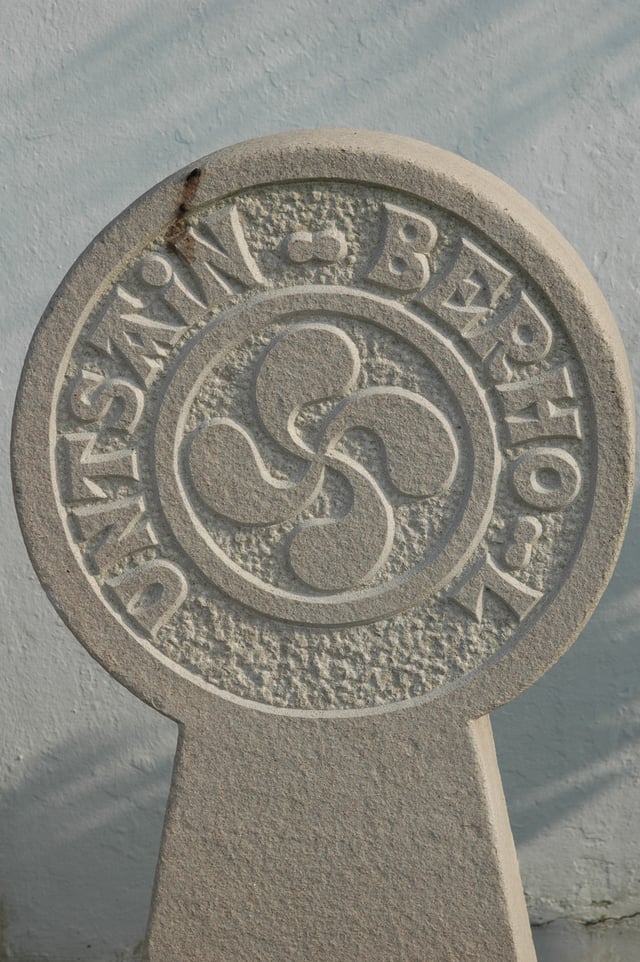
An example of Basque lettering in a funerary stela.

The letters of the alphabet in a Basque style font.
Basque is written using the Latin script including ñ and sometimes ç and ü. Basque does not use Cc, Qq, Vv, Ww, Yy for words that have some tradition in this language; nevertheless, the Basque alphabet (established by Euskaltzaindia) does include them for loanwords:[56]
- Aa Bb Cc (and, as a variant, Çç) Dd Ee Ff Gg Hh Ii Jj Kk Ll Mm Nn Ññ Oo Pp Qq Rr Ss Tt Uu Vv Ww Xx Yy Zz
The phonetically meaningful digraphs dd, ll, rr, ts, tt, tx, tz are treated as pairs of letters.
All letters and digraphs represent unique phonemes. The main exception is when l and n are preceded by i, that in most dialects palatalises their sound into /ʎ/ and /ɲ/, even if these are not written. Hence, Ikurriña can also be written Ikurrina without changing the sound, whereas the proper name Ainhoa requires the mute h to break the palatalisation of the n.
H is mute in most regions, but it is pronounced in many places in the northeast, the main reason for its existence in the Basque alphabet. Its acceptance was a matter of contention during the standardisation process because the speakers of the most extended dialects had to learn where to place these h's, silent for them.
In Sabino Arana's (1865–1903) alphabet,[57] digraphs ⟨ll⟩ and ⟨rr⟩ were replaced with ĺ and ŕ, respectively.
A typically Basque style of lettering is sometimes used for inscriptions. It derives from the work of stone and wood carvers and is characterised by thick serifs.
Number system used by millers
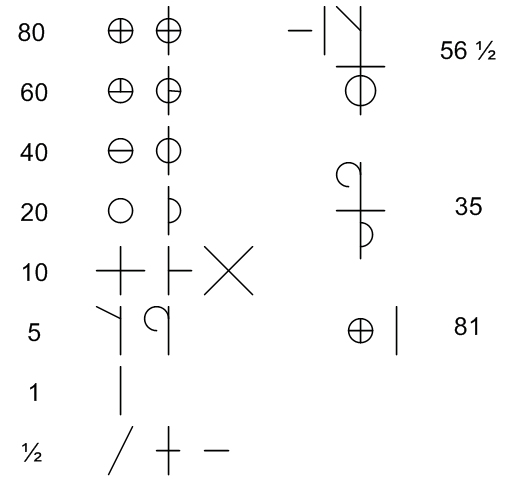
An example of the number system employed by millers.
Basque millers traditionally employed a separate number system of unknown origin.[58] In this system the symbols are arranged either along a vertical line or horizontally. On the vertical line the single digits and fractions are usually off to one side, usually at the top. When used horizontally, the smallest units are usually on the right and the largest on the left.
The system is, as is the Basque system of counting in general, vigesimal (base 20). Although the system is in theory capable of indicating numbers above 100, most recorded examples do not go above 100 in general. Fractions are relatively common, especially 1⁄2.
The exact systems used vary from area to area but generally follow the same principle with 5 usually being a diagonal line or a curve off the vertical line (a V shape is used when writing a 5 horizontally). Units of ten are usually a horizontal line through the vertical. The twenties are based on a circle with intersecting lines. This system is no longer in general use but is occasionally employed for decorative purposes.
Examples
Article 1 of the Universal Declaration of Human Rights
| Gizon-emakume guztiak aske jaiotzen dira, duintasun eta eskubide berberak dituztela; eta ezaguera eta kontzientzia dutenez gero, elkarren artean senide legez jokatu beharra dute. | Basque pronunciation: [ɡis̻onemakume ɡus̻tiak as̺ke jajots̻en diɾa | duintas̺un eta es̺kubide berbeɾak ditus̻tela | eta es̻aɡueɾa eta konts̻ients̻ia dutenes̻ ɡeɾo | elkaren artean s̺enide leges̻ jokatu beara dute] | All human beings are born free and equal in dignity and rights. They are endowed with reason and conscience and should act towards one another in a spirit of brotherhood. |
Esklabu erremintaria
| Esklabu erremintaria Sartaldeko oihanetan gatibaturik Erromara ekarri zinduten, esklabua, erremintari ofizioa eman zizuten eta kateak egiten dituzu. Labetik ateratzen duzun burdin goria nahieran molda zenezake, ezpatak egin ditzakezu zure herritarrek kateak hauts ditzaten, baina zuk, esklabu horrek, kateak egiten dituzu, kate gehiago. | IPA pronunciation [s̺artaldeko ojanetan ɡatibatuɾik eromaɾa ekari s̻induten es̺klabua eremintaɾi ofis̻ioa eman s̻is̻uten eta kateak eɡiten ditus̻u labetik ateɾats̻en dus̻un burdiɲ ɡoɾia najeɾan molda s̻enes̻ake es̻patak eɡin dits̻akes̻u s̻uɾe eritarek kateak auts̺ dits̻aten baɲa s̻uk es̺klabu orek kateak eɡiten ditus̻u kate ɡejaɡo] | The blacksmith slave Captive in the rainforests of the West they brought you to Rome, slave, they gave you the blacksmith work and you make chains. The incandescent iron you take out of the oven can be adapted as you wish, you could make swords so your people could break the chains, but you, o, slave, you make chains, more chains. |
| Joseba Sarrionandia | Joseba Sarrionandia |
See also
Basque dialects
Vasconic languages
List of Basques
Basque Country
Late Basquisation
Languages of France
Languages of Spain
Aquitanian language
List of ideophones in Basque
Wiktionary: Swadesh list of Basque words